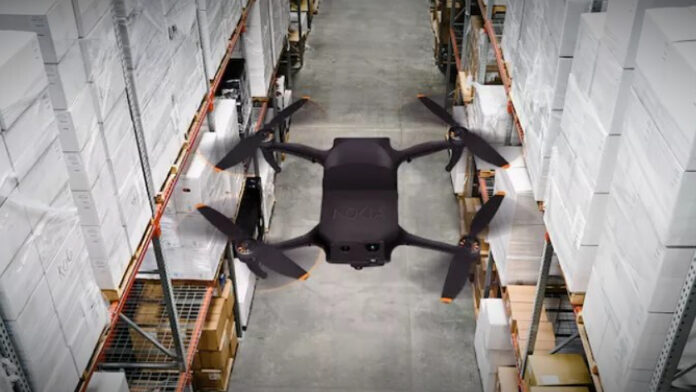Nokia has added a new drone-mounted automated counting function to its inventory monitoring service for warehouse customers in the US. It slots into its autonomous drone product, offered as part of its so-called Nokia AIMS (Autonomous Inventory Monitoring Service) package of drone-based logistics tools. The Finnish firm called it an “industry-first”, and said warehouse operators can now deploy indoor drones to automatically count individual items in any racked inventory locations.
The Nokia AIMS product (and division) was spun out from Nokia Bell Labs in the US last year, and initially presented as a drone-based autonomous industrial monitoring service (AIMS). It has since been recast, nominally, as a warehouse tool for robot inventory management. It uses autonomous drones and cloud-based analytics – to deliver “AI and automation” in the supply chain. “Drones… fly though warehouses, scanning inventory and constantly keeping managers up to date”, it says.
American wholesale distribution company Graybar was early to deploy the solution in its warehouses, signing a deal last year. Until now, its applications have been to find misplaced and lost inventory, as well as “empty bin detection”; the extended service uses the same drone-mounted machine vision technology to detect ‘eaches’ (individual items), cases (of items), and cartons on warehouse shelves. Nokia called it a “true inventory counting service”.
Nokia said: “If a human worker can count inventory from the aisle, the Nokia AIMS drone can count it too. Identified inventory counts are then compared with… warehouse management (WMS) or enterprise resource planning (ERP) systems to identify any mismatches… Whereas typical cycle counts use the ABC method, where inventory is counted based on varying frequency, [this] checks every location much more frequently, to ensure customers get a more accurate… picture.”
The product is delivered as-a-service, including drones, software, and a cloud user platform. Warehouse shrinkage can account for three-to-five percent of a company’s revenue, it said, quoting a 2024 research report; a quarter of shrinkage is down to administrative errors, it added. Nokia’s drone service can complete cycle counts seven-to-10 times faster than human workers, it suggested – at a rate of around 300 inventory checks per hour.
It is promising supply-chain customers a 40 percent (“or greater”) ROI, plus “immediate value”, and benefits with worker safety and workforce reorganisation (“reassignment from cycle counting to higher-value tasks”). It said interest is high because of the shrinkage issue, and also because “continued pressure to fulfil orders… has pushed warehouse operators to a tipping point of future-proofing and automating operations to gain a business edge”.
Paul Heitlinger, general manager for the AIMS product at Nokia, said: “Empowering warehouse operators with a competitive edge and keeping them at the forefront of automation is at the heart of what Nokia AIMS does… Our drones are designed to work while customers sleep but also free up human workers for high-value tasks that make a difference for their businesses.”
The service is only available in the US via a software update. It is offering the service for free on a 12-month deal to customers signing up before the end of the year.

